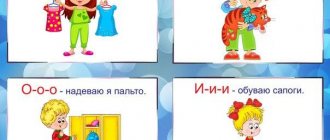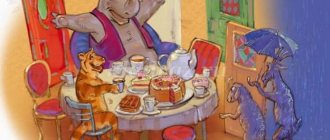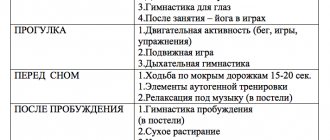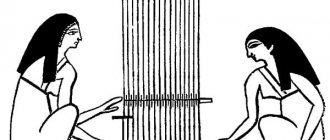Innovative technologies for the development of coherent speech in preschool children article on speech therapy
It is known that in preschool age children’s memory is involuntary, and their perception is visual-figurative.Visual modeling is the reproduction of the essential properties of the object under study, the creation of its substitute and work with it.
A picture in this technique is a “hook” that can hook knowledge and keep it in the child’s memory. From such pictures it is not at all difficult to create a mnemonic table on any topic: a fairy tale, poem, proverb or riddle. With the help of a mnemonic table, a child can easily learn to compose descriptive stories, retell a heard story or fairy tale, and quickly and easily memorize poetry.
The relevance of using the visual modeling method in working with preschoolers is that:
— Firstly, a preschool child is very flexible and easy to teach, but children are characterized by rapid fatigue and loss of interest in activities. Using visual modeling creates interest and helps solve this problem.
— Secondly, the use of symbolic analogy facilitates and speeds up the process of memorizing and assimilating material, and forms techniques for working with memory.
— Thirdly, using a graphic analogy, we teach children to see the main thing and systematize the knowledge they have acquired.
— Fourthly, using this technology, we develop in children the ability to formulate speech statements based on a model.
When using the visual modeling method, children become familiar with a graphical way of presenting information - a model. Symbols of various types can act as conditional substitutes (elements of the model):
- geometric figures;
-subject pictures;
-silhouette images;
-geometric figures.
Here are some sample tasks and games using visual modeling that are used in preschool childhood, starting from the younger group:
1.Mnemotables for fairy tales
1.1. Learning the technique of visual modeling using short Russian fairy tales: “Masha and the Bear”, “The Three Bears”, “Turnip”, “The Ryaba Hen”.
In order for children to learn to tell these short tales, various substitute objects are used to depict parts of the story or fairy tale. For example, a teacher tells the children the fairy tale “Ryaba the Hen,” and the children gradually expose symbols that stand for the heroes of the fairy tale and the events taking place in the fairy tale. At this stage, it is necessary to ensure that the manipulation of the model elements occurs in parallel with the reading of a specific fragment of a fairy tale, that is, each fragment of a fairy tale must be shown and put on the board during the reading process.
Elements of fairy tale modeling can be images of fairy tale characters, then they are replaced by substitute symbols (silhouette images or geometric figures). Gradually, children move from simply manipulating the elements of the model to composing a common fairy tale using a plan for retelling.
The use of the method of visual modeling of a coherent statement increases children's interest in this type of activity and allows one to achieve significant results in the development of speech in preschoolers.
1.2. For older and preparatory-age children, educators use Propp cards, because they have a number of advantages in the speech development of children: the clarity and colorfulness of their execution allows children to retain a large amount of information in memory, stimulate the development of mental processes, activate coherent speech, enrich their vocabulary, and develop logical thinking. So, what are Propp cards and how should you work with them?
The famous philologist and folklorist Vladimir Yakovlevich Propp studied Russian folk tales. Propp divided the tale into a set consisting of 28 cards, 20 of which are the main ones. One card is a certain event in a fairy tale. Propp's cards are a kind of fairy-tale construction set. The whole plot of a fairy tale is made up of events, like puzzles from a designer, and they allow you to organize children’s activities in a playful way.
Propp's maps contribute to the development of coherent speech, attention, perception, fantasy, creative imagination in children, and interest in search activity increases. Children learn to compose a new, interesting work of their own, in which good always triumphs over evil.
Preliminary lessons showed that children very actively act as writers of fairy tales. The specificity of using Propp cards for the speech development of children is that one of the most important skills in life is developed - the ability to speak clearly, understandably, and beautifully in their native language.
Work with Propp's maps will be presented in a lesson in a multi-age group with a compensatory focus.
1.3. Mnemonic tables are especially effective when learning poems. The bottom line is this: for each word or small phrase, a picture (image) is created; Thus, the entire poem is sketched schematically. After this, the child reproduces the entire poem from memory, using a graphic image. At the initial stage, the adult offers a ready-made plan - a diagram, and as the child learns, he is also actively involved in the process of creating his own diagram.
1.4. One of the types of visual modeling technology, which is an effective method of developing a child’s speech and allows you to quickly get results, is working on creating a non-rhyming poem - a syncwine.
Cinquain is translated from French as “five lines,” a five-line stanza of a poem.
The basic rules for compiling a syncwine include the following:
1 line - one keyword - title, title, topic, usually a noun defining the content (name of the subject, work, name of the hero, etc.);
Line 2 – two words (adjectives that describe the characteristics of an object or its properties.
words can be connected by conjunctions and prepositions.
Line 3 – three words (verbs). Actions of the subject related to the topic.
Line 4 – four words – a sentence. A phrase that shows the author's attitude to the topic.
Line 5 – one word – a summary word, association, synonym that characterizes the essence of the topic, usually a noun.
Today, dozens of domestic authors point to the great help of syncwine in establishing the correctness and meaningfulness of speech for preschool children.
Is it possible to teach syncwines to children who cannot yet read?
Of course you can. Everyone can make a syncwine. Composing a syncwine is like a game, because composing is fun, useful and easy!
In order to express his thoughts most correctly, completely and accurately, a child must have a sufficient vocabulary. Therefore, the work begins with clarifying, expanding and self-improving the dictionary.
You need to start with simple concepts, familiar topics.
What does a flower do - grow, bloom, smell, sway, dry up, wither.
A girl and a boy can perform several actions - looking, crying, smiling, screaming, jumping, running, sitting, playing.
What is shown in the picture: the cat is lying, the kettle is boiling.
Several signs for one object - yellow, sour, juicy, aromatic (lemon).
Children master the concepts of “living and inanimate” objects, learn to correctly pose questions to words denoting objects, actions and signs of objects, depict them graphically, as well as with the help of association pictures or objects. Graphic diagrams help children more specifically sense the boundaries of words and their separate spellings.
It is appropriate to compose a didactic syncwine at the end of each lexical topic, when children already have sufficient vocabulary on this topic. At first, when compiling a syncwine, it is planned to work with children in pairs, in small groups, and only then – individually.





